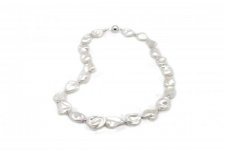suzannelowrie
New Member
I bought two strands of huge pearls that looked like high luster iridescent chewing gum: you know, the lumpy wad of bubble gum you chewed for an hour that has your tooth marks all over it? They were white freshwater, hence not kheshi. So what were they? Rebirth pearls. What??? Rebirth. They are solid nacre, with lusterous deep iridescent pools. At GIA they stopped the pearl lab instructor in his tracks. "Wow!" he said as he held the strand up to natural light. And there they sit in my house in Thailand. I don't know what to do with them. Too many large wads of high luster "chewed" pearls. They have such a high luster that I'm thinking of combining them with 4mm white AAA round Akoyas. The combination of saltwater and freshwater pearls is not new. Some freshwater have the same high luster as saltwater Akoyas. I tried varying these "chewed" pearls with 4mm freshwater pearls. Nope. So I'll be shopping in Vietnam for 100 4mm saltwater white Akoya pearls. Or maybe pink or blue-gray? Hah! you say. "What about bright yellow?" OK maybe with daffodil yellow Vietnamese Akoyas. We'll see. It is a pearl problem waiting to be solved.

